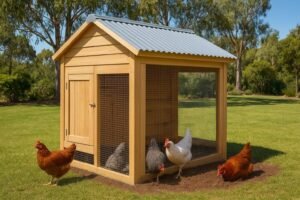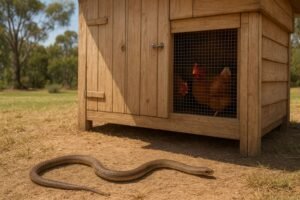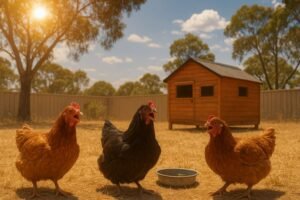G’day! If you’re anything like me, you know how tough our Aussie summers can be. Last year, during a nasty Sydney scorcher, I walked out to my backyard and saw my poor chooks panting, wings spread wide, looking absolutely miserable. When temperatures climb past 40°C in places like Queensland or New Sputh Wales, it’s not just uncomfortable for our birds; it’s dangerous.
Keeping your chooks cool, happy, and laying well is my top priority, and I bet it’s yours too. (If you need more quick tips, here’s a guide on keeping chickens cool in summer in Australia).
I’ve put together this guide for everyday backyard chicken keepers. This isn’t for big commercial farms; it’s for you. All the advice is practical, easy to understand, and fact-checked against the latest 2025 info from top Aussie sources like Poultry Hub Australia, Backyard Chicken Coops, and the DAFF (Department of Agriculture, Fisheries and Forestry), whose official guidelines are a key resource for animal welfare.
This guide is all about finding the best chicken coop designs for hot climates in Australia. We’ll cover everything from simple ventilation tricks to full-on build plans. We’ll answer crucial questions like ‘What is the best house design for extreme heat?’ and even show you ‘how to build a chicken coop for beginners’.
By the end of this, you’ll have a rock-solid plan to create a safe, airy, and cool home for your flock.
Best Chicken Coop Designs: The Three Pillars of Cool
When you’re looking for a coop, it’s easy to get sidetracked by cute designs. But in Australia, one thing matters more than anything: airflow. A pretty coop that’s an oven inside is useless.
The best designs all share three key things:
- Maximum Ventilation: To get hot air and humidity out.
- All-Day Shade: To stop heat from getting in.
- Predator Security: To keep chooks safe without sealing them in a box.
Let’s break down how to get these three pillars right, starting with the best overall design.
What is the Best House Design for Extreme Heat?
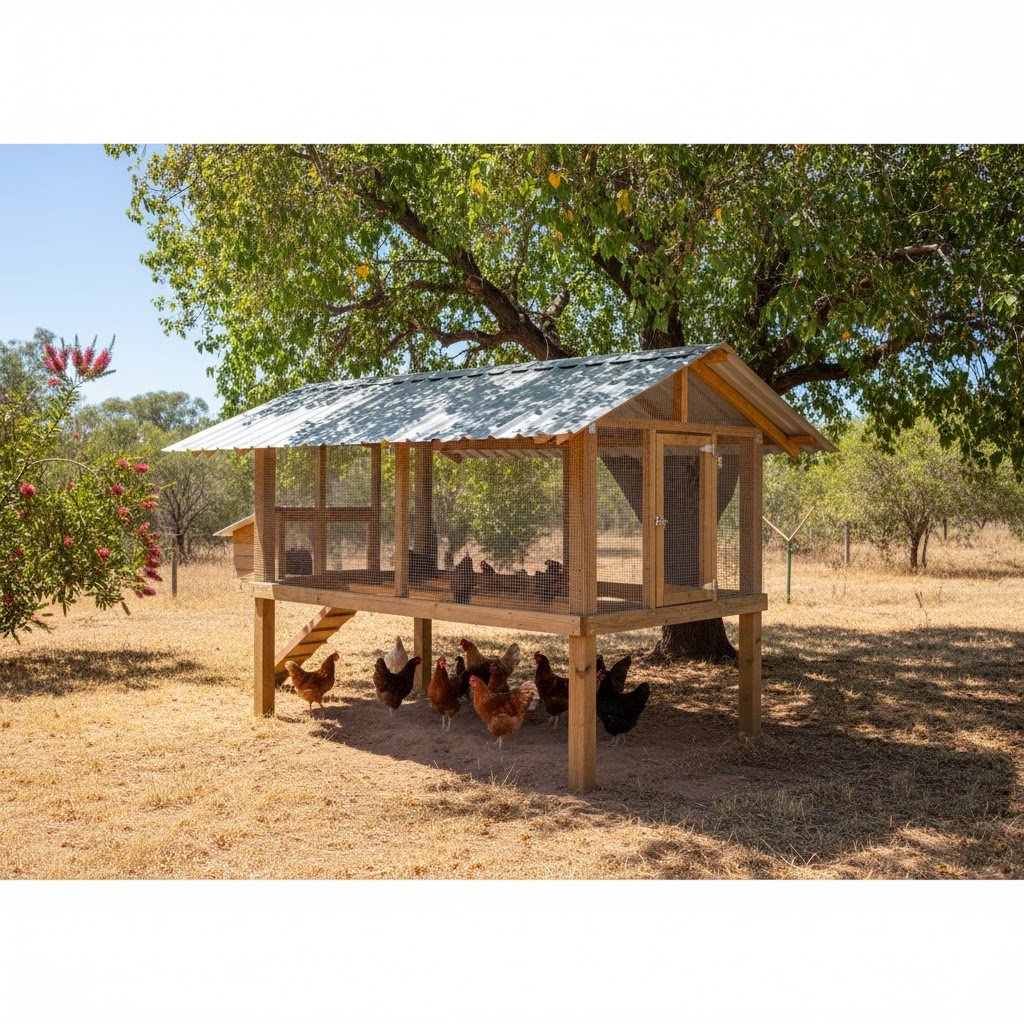
The single best house design for extreme heat is, without a doubt, an open-air chicken coop.
This design might be different from what you imagine. Instead of solid wooden walls, an open-air coop uses strong, predator-proof mesh for most (or all) of its walls. This is often paired with an elevated (raised) floor.
Think of it as a shady, secure pavilion rather than a stuffy little box. It’s the design I switched to in my QLD-border backyard, and it’s been a game-changer for preventing heat stress.
Here’s a quick look at the pros and cons of open air chicken coop plans:
| Pros | Cons |
|---|---|
| ✅ Maximum Airflow: Unbeatable cross-ventilation. | ❌ Less Winter Protection: Needs changes for cold nights. |
| ✅ Cooler Birds: Drastically reduces heat stress and panting. | ❌ Predator Proofing is Vital: You must use strong mesh. |
| ✅ Reduces Humidity: Less moisture build-up from droppings. | ❌ Driving Rain: Can get wet inside without a wide roof. |
| ✅ Less Ammonia: Better airflow means less stinky build-up. | ❌ Location Matters: Needs to be in a spot safe from gales. |
This design is perfect for our hot climates. You get all the security of a normal coop but with the airflow of, well, the great outdoors.
Popular Open Air Chicken Coop Plans (And Ideas)
You don’t need to buy complex blueprints. Here are two simple open air chicken coop plans to inspire you:
- “The QLD-er Pavilion”: This is my top pick.
- The Design: Imagine a simple, elevated timber cube (like a small deck on legs). It has a floor and a roof, but the four “walls” are just timber frames covered in 1/4″ or 1/2″ hardware cloth.
- The Roof: The roof is a simple, sloped metal sheet (light-coloured!) with a massive overhang on all four sides. This stops rain from blowing in and provides a huge circle of shade.
- The Nests: Nest boxes are built as a solid “pod” hanging off one side, so the hens can still have a dark, private spot to lay.
- “The Lean-To Breezeway”: This is great for smaller yards.
- The Design: You build the coop against an existing shed wall or solid fence (check council rules!). The two “side” walls are solid timber, but the entire “front” wall is 100% mesh, facing the breeze (and away from the afternoon sun).
- The Roof: The roof slopes down from the shed wall, again with a big overhang.
- The Benefit: It’s cheaper (uses one less wall) and uses the existing structure for shade and stability.
These open designs are the secret to happy chooks in hot weather. But even a good design needs the right features to work.
Chicken Coop for Hot Climates: Key Features to Look For
Even if you don’t go for a full open-air design, any good chicken coop for hot climates must have these features. Getting these right is more important than the design itself.
1. Serious Shade (It’s Non-Negotiable)
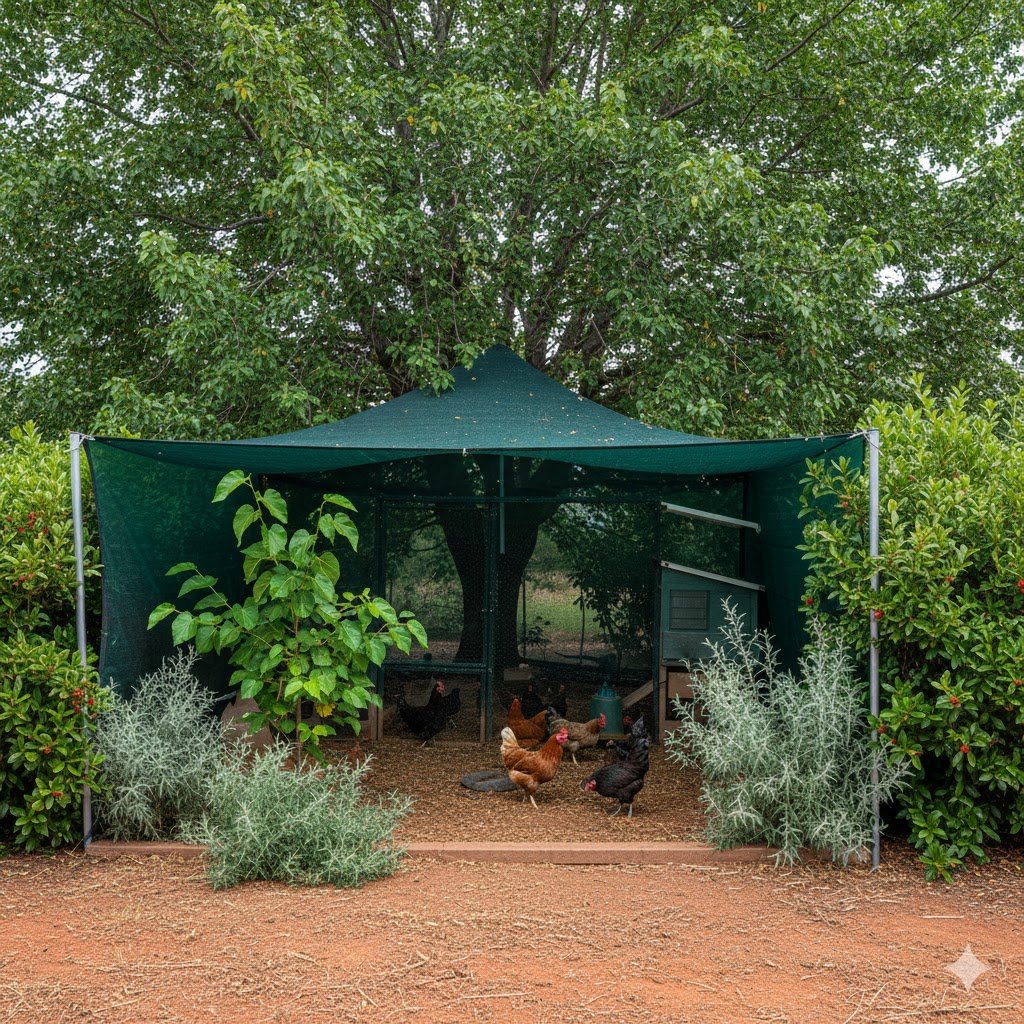
- Big Overhangs: The roof should stick out at least 30-50cm past the walls. This stops the hot midday and afternoon sun from hitting the walls directly.
- Shade Cloth: Use 70-90% shade cloth over the entire run and even over the coop roof itself. This is a cheap and instant fix.
- Smart Placement: As expert groups like Vets for Climate Action recommend, don’t put the coop next to a hot tin fence or a brick wall that radiates heat. Place it under a big deciduous tree (shade in summer, sun in winter!). Finding the best place to put your chicken coop is your first step to beating the heat.
Landscaping for Shade: The Two-for-One Trick
This is a pro-tip. Plant chicken-safe, fast-growing plants around the coop. They provide shade and enrichment. Good Aussie choices include:
- Mulberry Tree: Deciduous, so it lets winter sun in. Chooks love the berries.
- Old Man Saltbush: A tough native that provides good shade and is nutritious for chooks to peck at.
- Native Lilly Pilly: Can be grown as a dense hedge to block afternoon sun.
2. A Reflective, Insulated Roof
- Colour: A light-coloured roof (like classic Zincalume or light-coloured Colorbond) reflects sunlight. A dark roof absorbs it and turns your coop into an oven.
- Insulation: This is my number one secret weapon. Get a roll of silver “sarking” or foil-backed bubble insulation from Bunnings. Staple it under the roof.
- Pro-Tip: Make sure there’s an air gap (a few cm) between the hot metal roof and the insulation. This “radiant barrier” system is what stops the radiant heat before it gets into the coop.
3. Cool Water, 24/7 (and More)
- Your chooks’ water needs to be cool, clean, and in the shade. On a 40°C day, a chicken can drink half a litre of water!
- Use Multiple Sources: Have at least two drinkers in different shady spots. If one gets knocked over or runs out, they have a backup.
- Add Ice: A big block of ice (from an old takeaway container) in the drinker works wonders. This is one of the top tips recommended by Backyard Chicken Coops for beating the heat.
- Nipple Drinkers: Consider a nipple-style drinker (like those from Dine-A-Chook) as they stay cleaner and cooler than open bowls.
- Electrolytes: On extreme heat days, add a pinch of electrolytes (store-bought, or a tiny pinch of bicarb soda and sea salt) to their water to help them recover. It’s also important to know what to feed chickens during a heatwave to minimise stress.
4. An Elevated (Raised) Floor
- Getting the coop off the hot ground is a massive win.
- It allows air to flow under the coop, cooling the floor.
- Slatted vs. Solid: A slatted floor (like a deck) is amazing for airflow but can be messy. A solid plywood floor (covered in vinyl) is easier to clean. For hot climates, a slatted floor on an elevated coop is hard to beat.
- Bonus Shade: The space underneath becomes a great shady spot for your chooks to dust bathe during the day.
5. Choosing Your Coop Materials: Timber vs. Plastic vs. Metal
The material your coop is made from has a huge impact on heat.
- Timber:
- Pros: Good natural insulator, easy to work with, looks great.
- Cons: Can rot, and tiny gaps are perfect hiding spots for red mites.
- Best Use: The main frame and solid walls. Use untreated pine for the structure and paint it with a light-coloured, non-toxic paint.
- Plastic (e.g., Omlet, Somerzby):
- Pros: Very easy to clean (no mite hidey-holes!), durable, often modular.
- Cons: Can get extremely hot (like a car), expensive.
- Best Use: Only if placed in 100%, all-day, deep shade. A plastic coop in the sun is a death trap.
- Metal (e.g., Somerzby, Royal Rooster):
- Pros: Very durable, 100% predator-proof, easy to clean.
- Cons: Conducts heat fast. A metal wall in the sun will be dangerously hot.
- Best Use: Like plastic, it must be in full shade. The roof must be insulated. Great for runs and frames, but be wary of all-metal coops.
These features are the core of smart chicken coop ideas Australia-style. Get them right, and you’re 90% of the way to a cool coop.
What is the Best Ventilation for a Chicken Coop?
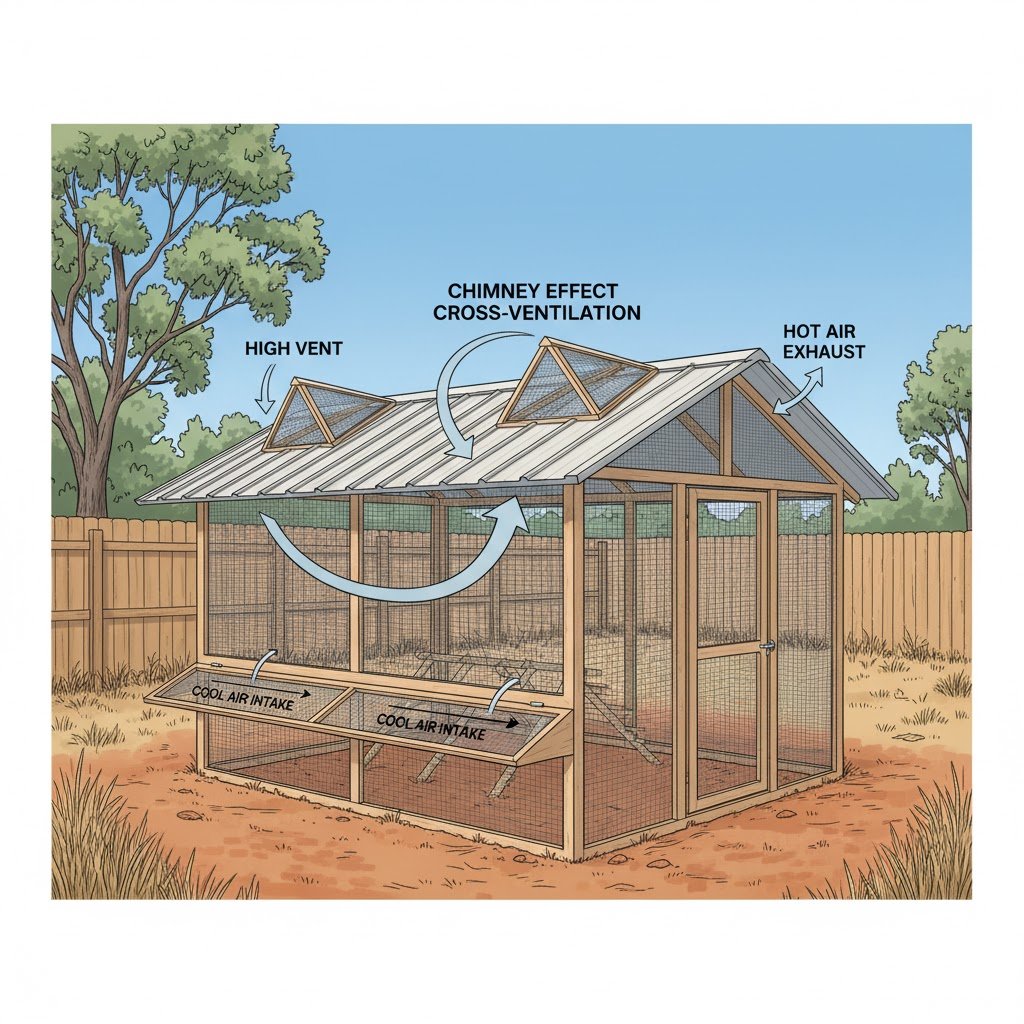
This is the big one. So, what is the best ventilation for a chicken coop?
The best ventilation is passive cross-ventilation that works 24/7. This means you need vents that let cool air in and hot air out, creating a constant, gentle breeze.
The Big Mistake: People often confuse ventilation (good) with a draft (bad).
- Ventilation: Vents high up, above the birds’ heads, that let hot, stinky, moist air escape.
- Draft: A cold wind blowing directly onto your chooks while they roost, making them sick.
You always want ventilation, even in winter. But you never want a draft. According to Poultry Hub Australia, the build-up of moisture and ammonia (from their poo) is a major cause of respiratory disease. Good airflow fixes this and cools the coop.
How Much Ventilation Do I Need? (The “Math”)
Here are two rules of thumb used by pros, but for a full breakdown, check this guide on how much ventilation a chicken coop needs.
- The 1-in-10 Rule: Aim for at least 1 square foot of ventilation for every 10 square feet of floor space. (e.g., a coop that is 1m x 2m is 2 sq metres, or ~21 sq ft. You’d need ~2.1 sq ft of vent).
- The 50/50 Rule: Split your vents 50/50. Half your ventilation should be low (inlets) and half should be high (outlets) to create that “chimney effect.”
As Aussie suppliers like Somerzby note, practical ventilation is about balancing airflow with safety and protecting birds from the elements.
In hot climates, more is more. An open-air coop has hundreds of square feet of ventilation, which is why it works so well.
Chicken Coop Ventilation Ideas
Here are some simple chicken coop ventilation ideas you can use:
- Mesh Walls: The ultimate ventilation. As we covered in the open air chicken coop plans, replacing solid walls with 1/2 inch (12.5mm) or 1/4 inch (6.5mm) hardware cloth (that’s the strong, fox-proof mesh) is the best option for hot climates.
- Gable & Ridge Vents: These are vents at the very peak of your coop’s roof. Since hot air rises, these vents let it escape at the highest point.
- Whirlybirds: A classic Aussie roof icon! A whirlybird actively sucks hot air out of the coop. They are fantastic and non-electric.
- Slatted Floors: If you have an elevated coop, a floor from spaced wooden slats gives amazing ventilation and lets droppings fall straight through.
- Opening Windows: Sounds obvious, but make sure windows are large, on opposite sides of the coop (for cross-flow), and covered with strong hardware cloth, not flimsy flyscreen.
Chicken Coop Ventilation Diagram
It’s hard to show in text, but here is a simple chicken coop ventilation diagram to picture in your head for a solid-wall coop:
- LOW VENTS: Imagine long, rectangular vents covered in mesh, low on the coop walls (but below the roosts, so they don’t cause a draft on the birds).
[ -> COOL AIR IN -> ] - ROOSTS: Your chooks are roosting in the middle, above the low vents.
[ --- Chooks Here --- ] - HOT AIR: Their body heat, and the hot air from the day, rises.
[ ^^^ HOT AIR RISES ^^^ ] - HIGH VENTS: Vents at the very top of the walls or in the roof gable, as high as possible.
[ -> HOT AIR OUT -> ]
This creates a natural “chimney effect” or “stack effect,” constantly pulling fresh air in and pushing hot, humid air out.
Chicken Coop Ventilation Fan (and Misting)
For those terrible 40°C+ days, sometimes passive ventilation isn’t enough.
- A Chicken Coop Ventilation Fan: A solar-powered ventilation fan is a lifesaver. Mount it high up, blowing out, to help pull hot air from the coop. Make sure all cords are secure and chooks can’t peck at them.
- Misting Systems: BE VERY CAREFUL. Misters are often suggested, but they are a terrible idea in humid climates like QLD, NSW, or VIC in summer. As vets warn, they just make the air more humid, which makes it harder for chooks to cool themselves by panting. Misters only work in dry heat (like SA or inland).
Getting this right is crucial, as there are many common coop ventilation mistakes that overheat your flock. Proper ventilation is your best friend all year round, but it needs a small tweak for the colder months.
Chicken Coop Vents for Winter: Balancing Airflow
A lot of people ask, “What about chicken coop vents for winter? Won’t my chooks freeze?”
This is a great question. Here’s the most important rule: DO NOT seal your coop in winter.
A sealed-up coop traps moisture (from their breath and poo) and ammonia. This combination is far more dangerous to your chooks’ health than the cold is. As the RSPCA Approved Standards make clear, good air quality is a non-negotiable part of animal welfare. A damp, stinky coop leads to respiratory infections and frostbite (on their combs). This is a key part of biosecurity.
The Solution:
- Keep Top Vents Open: Your high-up vents (gable/ridge) should stay open all year. They let the moisture and ammonia escape without creating a draft down where the birds are.
- Block Low Drafts: This is the key. You need to block the wind, not the air. If you have a full open-air coop, you need removable panels for winter.
- Deep Litter Method: Use a thick layer (15-20cm) of dry bedding (like hemp or pine shavings). This composts in place, generating a tiny bit of warmth and keeping the floor dry.
How to Make Removable Winter Panels (Actionable Tip)
This is the best way to winter-proof an open-air coop:
- Buy U-channel aluminium or plastic strips from Bunnings.
- Screw these strips to the outside of your mesh-wall frame, top and bottom.
- Cut a sheet of clear Perspex (for light) or cheap plywood to the right size.
- In winter, just slide the panel into the channels to block wind and rain. In spring, slide it out. It’s that easy.
With a well-managed coop, even small ones can stay cool and safe for a small flock.
Best Small Chicken Coop Designs for Urban Backyards

If you’re in a Sydney suburb or a Brisbane backyard, you probably don’t have space for a massive coop. You need the best small chicken coop that is still cool and practical.
Here’s a comparison of the top 3 designs for small flocks (2-4 chooks):
| Design | Heat Pros | Heat Cons | Best For… |
|---|---|---|---|
| The “Tractor” (Mobile Coop) | Moves to fresh grass/shade. | Very small, low airflow. Can be an oven if left in the sun. | Renters or small yards. Must be moved to deep shade by 10 am. |
| The Elevated A-Frame | Classic design. Run underneath is shaded. | The sleeping box is often small, high up, and gets very stuffy. | 2-3 birds, DIYers. Needs extra vents cut into the sleeping box. |
| The Modular Plastic (e.g., Omlet) | Easy to clean (hygiene), mite-resistant. | Plastic gets hot fast. Ventilation is often just a few small holes. | Beginners who want easy cleaning. Must be placed in 100% full shade. |
The Verdict: For hot climates, the best small chicken coop is often a small-scale DIY “Pavilion” style. If buying pre-fab, brands like Royal Rooster (an Aussie company) make many designs with mesh walls and elevated legs, which are a great choice.
Even if you buy, learning how a coop should be built will help you make the right choice.
How to Build a Chicken Coop for Beginners (Step-by-Step)
Want to save money and get the perfect design? (You can even learn how to build a chicken coop for under $200). Here’s how to build a chicken coop for beginners, with a focus on our hot climate. We’ll focus on that simple, elevated, open-air “Pavilion” design.
Step 1: Plan & Check Council Rules
- Before you buy a single bit of timber, check your local council rules (Brisbane City Council, Sydney councils, etc.). They have rules on a) if you can have chooks, b) how many, and c) how far the coop must be from your fence.
- Decide on your flock size. The Australian Animal Welfare Standards for Poultry provide the official guidelines. For backyard flocks, a good rule is at least 0.5 square metres of floor space inside the coop per bird, and 1 square metre of run space (more is always better).
Step 2: Pick Your Spot
- Find a spot with good morning sun (to dry out the coop) and deep afternoon shade (from 11 am onwards). This is critical, so check out this full guide on the best place to put your chicken coop.
- Make sure it’s on high ground (no-puddles) and catches any local breezes.
Step 3: Gather Materials
- Frame: Treated pine (CCA-treated) for anything touching the ground. Untreated pine for the rest.
- Mesh: Hardware Cloth (1/2″ or 1/4″ mesh). DO NOT USE CHICKEN WIRE. Foxes, quolls, and goannas can tear right through chicken wire. This is your biggest expense, but it’s the most important.
- Roofing: A light-coloured metal roof sheet.
- Floor: Marine plywood (if solid) or hardwood decking timber (if slatted).
- Fixings: Good quality outdoor screws and heavy-duty staples for the mesh. Pro-Tip: Use screws, not nails. Nails work loose over time, creating gaps for predators.
Step 4: Build the Elevated Frame
- Build a strong, square base on four legs. Get it at least 60cm off the ground. This creates that shady spot underneath and makes it harder for predators.
Step 5: Add Floor & Walls
- Fix your floor. If solid, cover it with a bit of vinyl flooring (an offcut is perfect) to make cleaning a breeze.
- For the walls, build simple square frames. Staple the hardware cloth TIGHT to the inside of the frames. This stops animals from “pushing” the mesh out.
- Cover one or two walls (the ones facing the worst weather) with solid timber or plywood, but leave at least two walls as 90-100% mesh.
Step 6: Put a Lid On It
- Add the roof. Make sure it has a big overhang (at least 30cm) on all sides.
- Don’t forget to install that silver sarking insulation underneath!
Step 7: The “Furniture”
- Roosts: Add thick branches or 50mm x 50mm timber (with the sharp edges sanded off) for them to sleep on. This must be higher than the nest boxes (or they’ll sleep in the nests).
- Nest Boxes: Add one nest box for every 3-4 hens. Make them dark, private, and easy for you to access from the outside to collect eggs.
Step 8: Predator-Proof Everything
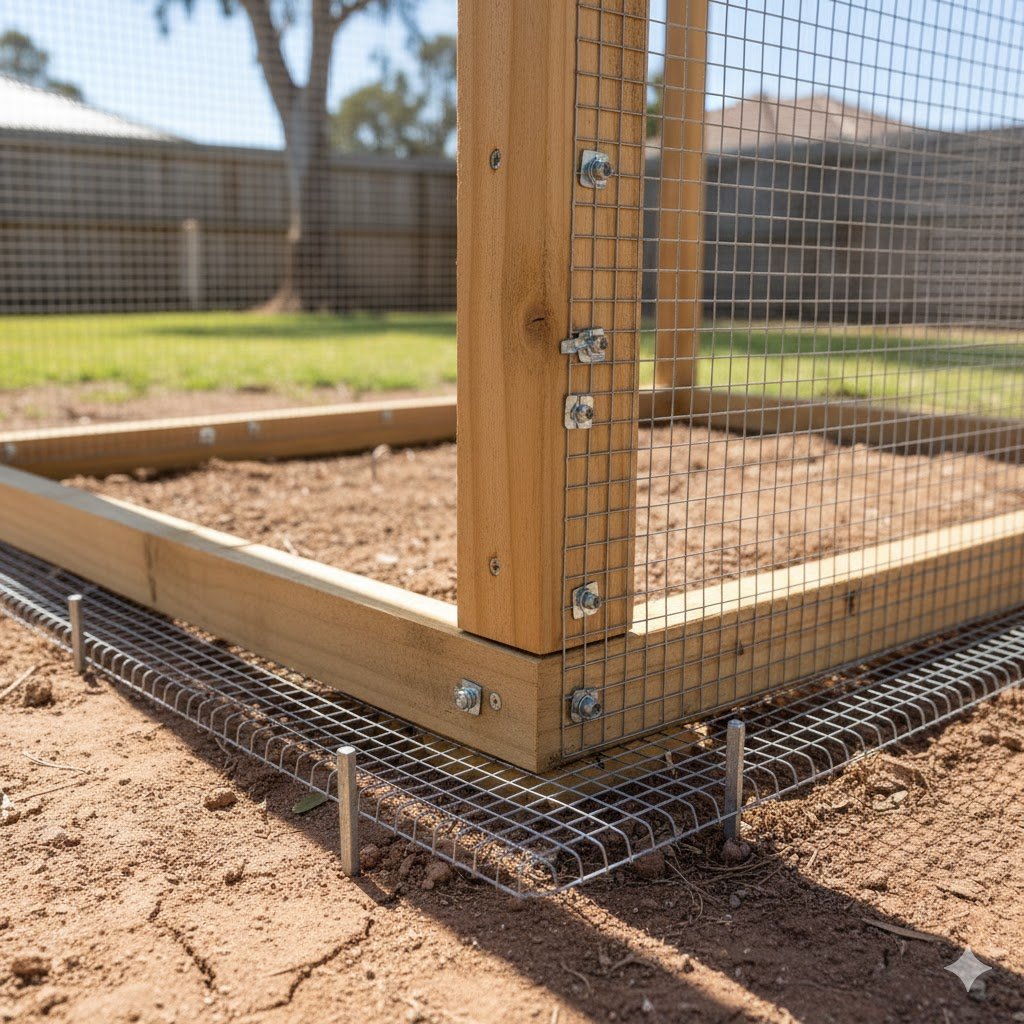
- Foxes are clever. Go around your finished coop and check for any gap. If you can fit a finger, a snake or rat can get in.
- Use strong, lockable latches on all doors. A simple hook is not enough. For ultimate convenience and security, many people are now using the best automatic chicken coop doors (Australian) models.
This is the perfect DIY chicken coop hot weather project. But predator proofing is so important, it needs its own section.
Pro-Level Predator Proofing (Don’t Skip This!)
A mesh coop is only safe if the mesh is right. This is the key to protecting your flock from Australian predators.
- Mesh Size: For foxes and dogs, 1/2″ (12.5mm) hardware cloth is fine. For snakes, quolls, and small rats, you must use 1/4″ (6.5mm) mesh. This is the first step in how to snake-proof your chicken coop.
- The “Apron”: This is a non-negotiable. Don’t just bury your mesh. Instead, dig a 30-40cm wide “apron” of hardware cloth flat on the ground running outwards from the base of your run, and peg it down. Foxes and goannas always dig right at the wall. They can’t dig through an apron.
- Secure Latches: Use barrel bolts or latches that require two “actions” (e.g., a carabiner clip) to open.
A secure coop is a cool coop. But even with the best coop, you need to know the signs of trouble.
Beyond the Coop: Spotting and Treating Heat Stress
This is the most important section in this guide. Even with a perfect coop, an extreme heatwave can be deadly. As Australian vets point out, chickens can’t sweat and are very prone to heat stroke. You must know how to spot heat stress and act fast.
Signs of Heat Stress in Chickens
Look for these signs, in order of severity:
- Panting (Gular Flutter): Beak open, throat vibrating fast. This is their main way to cool off.
- Wings Spread: Holding their wings away from their body to release heat.
- Lethargy: Standing still, looking floppy, not interested in food or treats.
- Pale Comb & Wattles: This is a bad sign. It means their circulation is struggling.
- Diarrhea: Watery, “stress” poos.
- Collapse / Seizures: This is a life-threatening emergency.
How to Cool a Chicken Down (Emergency Actions)

If you see a chook showing signs of lethargy or paleness (Stage 3-4), follow these emergency steps:
- Act Fast: Bring the bird inside immediately. The laundry or a shady bathroom is perfect.
- Cool (Not Cold) Water: Stand the bird in a tub with a few inches of cool water (not icy). This cools their feet and legs, bringing down their core temperature.
- Electrolytes: Offer them cool water with electrolytes.
- Fan: Place them in a carrier or box in front of a gentle fan.
- DO NOT spray the bird with water (this can be a shock). Dip their feet and offer water to drink.
Knowing these signs is just as important as building the coop itself.
FAQs: Chicken Coop Design, Ventilation, and Shade
Q: How do I stop my chicken coop from smelling in the heat?
A: Smell is usually ammonia from droppings. The cure is ventilation and clean bedding. As RSPCA guidelines stress, clean, dry litter and good air quality are essential. The “deep litter method” (15-20cm of good carbon-rich bedding like hemp) can work well if managed properly. Otherwise, a weekly clean-out and good high-up ventilation will solve it.
Q: What are the best chicken breeds for hot Australian climates?
A: Good question! Lighter-coloured breeds with large combs generally do better. Leghorns are heat-hardy and amazing layers. Our own Australorps are a great all-rounder, and Isa Browns (the classic backyard layer) cope well if given plenty of shade and cool water.
Q: How do I predator-proof my open-air coop?
A: Use hardware cloth (1/4″ or 1/2″ mesh), NOT chicken wire. Staple it on the inside of the timber frame. Use two-step latches on all doors (e.g., a barrel bolt plus a carabiner). And must install a 30-40cm mesh “apron” on the ground. For complete peace of mind, you might want to look at specific snake-proof chicken coop designs.
Q: What is a ‘chicken tractor’ and is it good for hot weather?
A: A chicken tractor is a mobile coop-and-run combo. It’s a type of best small chicken coop. It’s only good for hot weather if you are disciplined and move it into deep shade every single day. If left in the sun, it will cook your chooks.
Q: Can I just use a fan?
A: A chicken coop ventilation fan is a great extra tool, but it’s not a replacement for a bad design. Your first step must be shade and passive airflow, which, as suppliers like Somerzby explain, is your main line of defence. Think of the solar fan for chicken coop as your emergency boost for those 40°C+ days.
Q: Do misting systems work for chicken coops in Queensland?
A: Be very careful! As Vets for Climate Action warn, in high-humidity areas (like QLD or coastal NSW), misters make the air wetter, which makes it harder for chooks to cool down. They are only effective in dry heat (like SA or inland).
Q: What’s the best insulation for a chicken coop roof?
A: Reflective foil sarking (like a radiant barrier) is the best for our hot climate, as it reflects the sun’s radiant heat. Polystyrene (EPS) boards also work well for insulating against conducted heat. Using both is the ultimate, but foil sarking is the most important.
Conclusion: Your Cool Coop Plan
Whew! That was a lot, but keeping your chooks cool in our scorching summers is a serious business. It all comes down to smart design.
We’ve covered the best chicken coop designs for hot climates in Australia, and hopefully, you’re feeling confident. Remember the big three: Shade, Airflow, and Cool Water.
Whether you buy a pre-fab coop from Somerzby or Omlet, or you’re firing up the tools for a DIY chicken coop hot weather build, focus on those three things. Your chooks will be happier, healthier, and will keep laying those beautiful eggs, even when the thermometer is screaming.
Good luck, and stay cool out there!

Oladepo Babatunde is the founder of ChickenStarter.com. He is a backyard chicken keeper and educator who specializes in helping beginners raise healthy flocks, particularly in warm climates. His expertise comes from years of hands-on experience building coops, treating common chicken ailments, and solving flock management issues. His own happy hens are a testament to his methods, laying 25-30 eggs weekly.

